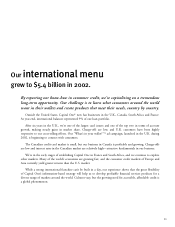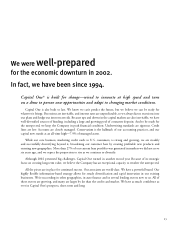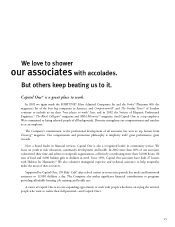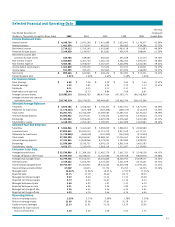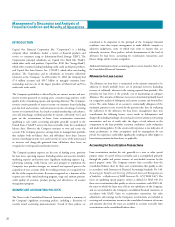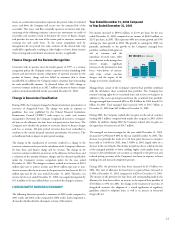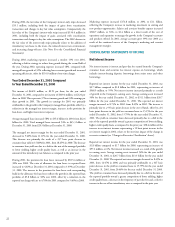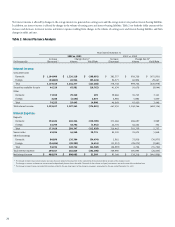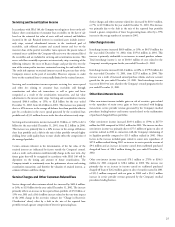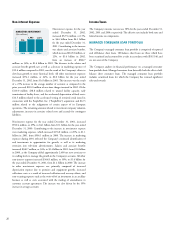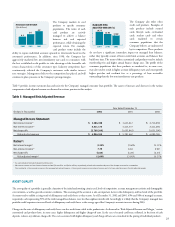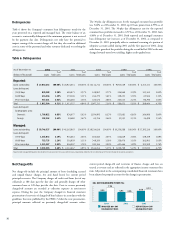Capital One 2002 Annual Report Download - page 22
Download and view the complete annual report
Please find page 22 of the 2002 Capital One annual report below. You can navigate through the pages in the report by either clicking on the pages listed below, or by using the keyword search tool below to find specific information within the annual report.
20
considered to be important to the portrayal of the Company’s financial
condition, since they require management to make difficult, complex or
subjective judgements, some of which may relate to matters that are
inherently uncertain. These policies include determination of the level of
allowance for loan losses, accounting for securitization transactions, and
finance charge and fee revenue recognition.
Additional information about accounting policies can be found in Note A to
the Consolidated Financial Statements.
Allowance for Loan Losses
The allowance for loan losses is maintained at the amount estimated to be
sufficient to absorb probable losses, net of principal recoveries (including
recovery of collateral), inherent in the existing reported loan portfolio. The
provision for loan losses is the periodic cost of maintaining an adequate
allowance. The amount of allowance necessary is determined primarily based
on a migration analysis of delinquent and current accounts and forward loss
curves. The entire balance of an account is contractually delinquent if the
minimum payment is not received by the payment due date. In evaluating
the sufficiency of the allowance for loan losses, management takes into
consideration the following factors: recent trends in delinquencies and
charge-offs including bankrupt, deceased and recovered amounts; forecasting
uncertainties and size of credit risks; the degree of risk inherent in the
composition of the loan portfolio; economic conditions; credit evaluations
and underwriting policies. To the extent credit experience is not indicative of
future performance or other assumptions used by management do not
prevail, loss experience could differ significantly, resulting in either higher or
lower future provision for loan losses, as applicable.
Accounting for Securitization Transactions
Loan securitization involves the sale, generally to a trust or other special
purpose entity, of a pool of loan receivables and is accomplished primarily
through the public and private issuance of asset-backed securities by the
special purpose entity. The Company removes loan receivables from the
consolidated balance sheet for those asset securitizations that qualify as sales
in accordance with Statement of Financial Accounting Standards No. 140,
Accounting for Transfers and Servicing of Financial Assets and Extinguishments
of Liabilities - a Replacement of FASB Statement No. 125 (“SFAS 140”). The
trusts are qualifying special purpose entities as defined by SFAS 140. For
those asset securitizations that qualify as sales in accordance with SFAS 140,
the trusts to which the loans were sold are not subsidiaries of the Company,
and are not included in the Company’s consolidated financial statements in
accordance with GAAP. Gains on securitization transactions, fair value
adjustments and earnings on the Company’s securitizations are included in
servicing and securitizations income in the consolidated statement of income
and amounts due from the trusts are included in accounts receivable from
securitizations on the consolidated balance sheet.
INTRODUCTION
Capital One Financial Corporation (the “Corporation”) is a holding
company whose subsidiaries market a variety of financial products and
services to consumers using its Information-Based Strategy (“IBS”). The
Corporation’s principal subsidiaries are Capital One Bank (the “Bank”),
which offers credit card products, Capital One, F.S.B. (the “Savings Bank”),
which offers consumer lending (including credit cards) and deposit products,
and Capital One Auto Finance, Inc. (“COAF”), which offers auto lending
products. The Corporation and its subsidiaries are hereafter collectively
referred to as the “Company.” As of December 31, 2002, the Company had
47.4 million accounts and $59.7 billion in managed consumer loans
outstanding and was one of the largest providers of MasterCard and Visa
credit cards in the world.
The Company’s profitability is affected by the net interest income and non-
interest income generated on earning assets, consumer usage patterns, credit
quality, levels of marketing expense and operating efficiency. The Company’s
revenues consist primarily of interest income on consumer loans (including
past-due fees) and securities, and non-interest income consisting of servicing
income on securitized loans, fees (such as annual membership, cash advance,
cross-sell, interchange, overlimit and other fee income, collectively “fees”) and
gains on the securitizations of loans. Loan securitization transactions
qualifying as sales under accounting principles generally accepted in the
United States (“GAAP”) remove the loan receivables from the consolidated
balance sheet. However, the Company continues to own and service the
account. The Company generates earnings from its managed loan portfolio
that includes both on-balance sheet and off-balance sheet loans. Interest
income, interchange income, fees, and recoveries in excess of the interest paid
to investors and charge-offs generated from off-balance sheet loans are
recognized as servicing and securitization income.
The Company’s primary expenses are the costs of funding assets, provision
for loan losses, operating expenses (including salaries and associate benefits),
marketing expenses and income taxes. Significant marketing expenses (e.g.,
advertising, printing, credit bureau costs and postage) to implement the
Company’s new product strategies are incurred and expensed prior to the
acquisition of new accounts while the resulting revenues are recognized over
the life of the acquired accounts. Revenues recognized are a function of the
response rate of the initial marketing program, usage and attrition patterns,
credit quality of accounts, product pricing and effectiveness of account
management programs.
SIGNIFICANT ACCOUNTING POLICIES
The Notes to the Consolidated Financial Statements contain a summary of
the Company’s significant accounting policies, including a discussion of
recently issued accounting pronouncements. Several of these policies are
Management’s Discussion and Analysis of
Financial Condition and Results of Operations



